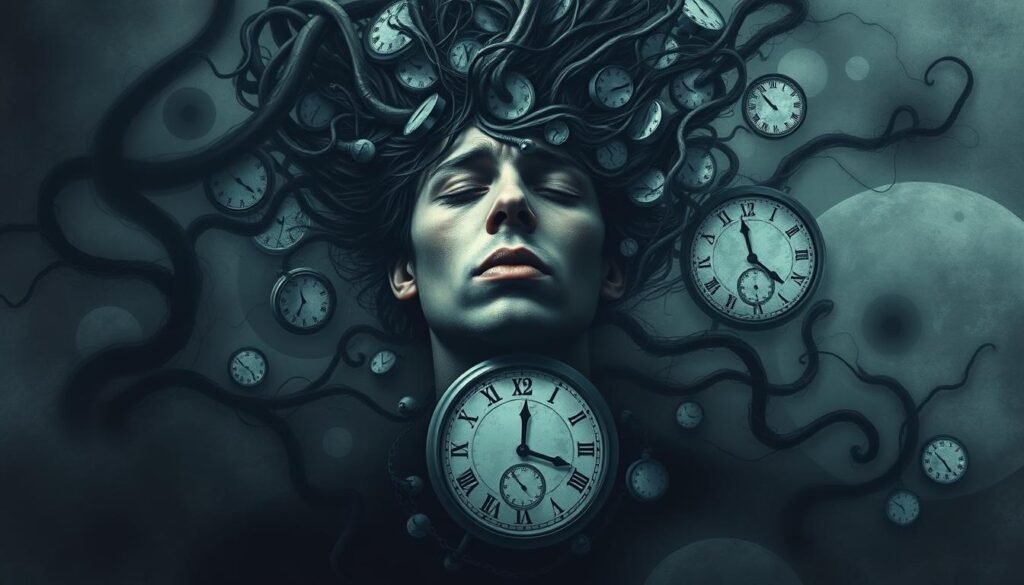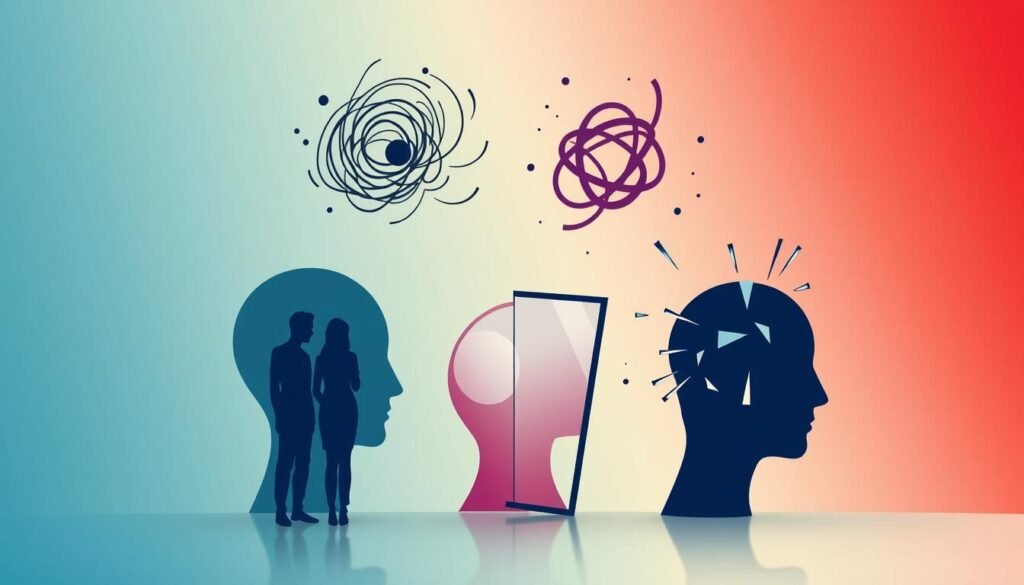Surprisingly, nearly 40 million adults in the United States struggle with anxiety disorders. This makes them the top mental health issue in the country. Understanding the difference between chronic and acute anxiety is key. Acute anxiety comes on fast, bringing intense fear or worry during certain situations. On the other hand, chronic anxiety lasts for weeks, months, or even years, deeply affecting daily life.
Knowing how long anxiety lasts is vital for those dealing with anxiety attacks or ongoing worry. It helps in choosing how to treat it. Acute anxiety doesn’t last long, hitting hard during specific moments and fading when the issue is addressed. Meanwhile, chronic anxiety stays, bringing prolonged stress that makes everyday tasks harder and calls for more in-depth treatment.
Key Takeaways
- Chronic anxiety lasts weeks to years, while acute anxiety is temporary and linked to specific triggers.
- Nearly 40 million adults in the US are affected by anxiety disorders, indicating a widespread issue.
- Acute anxiety can lead to intense anxiety attacks that peak within minutes.
- Chronic anxiety can severely impact daily functioning and emotional well-being.
- Understanding the type of anxiety is essential for effective management and treatment.
Understanding Anxiety: The Basics
Anxiety is our body’s way of reacting to stress. It’s like an alarm for potential danger. The definition of anxiety covers feelings from worry to fear that come up in different situations. Think about big changes in life or before an exam. It’s normal to feel this way sometimes. But it’s not okay when the worry doesn’t go away and messes with everyday life.
About 1 in 5 American adults deal with anxiety disorders each year. That’s a lot of people. Most worries are about health, money, or personal matters. When these worries get too strong, they might point to an anxiety disorder. Social anxiety affects about 15 million U.S. people. And generalized anxiety disorder hits 7 million people in the country.
Panic disorder is another type that’s common, affecting around 6 million Americans. It’s more common in women. Many kids and teens go through anxiety disorders too. Half of all mental health issues start by age 14. Anxiety can come from our genes, the environment around us, or stressful events. This makes treating mental health very complicated.
Cognitive behavioral therapy, or CBT, helps people deal with anxiety. It changes the way they think about what worries them. CBT has really made a difference for many facing anxiety. Doctors are always looking for new ways to help, like better brain scans. They want to make treatment that’s just right for each person.
Knowing the anxiety basics is the first step to handle these issues. It’s good to know how common anxiety is and what can be done about it. There are treatments that can help. For more info, you can check out types of anxiety disorders. Or look up ways to manage anxiety from mental health experts.
What is Acute Anxiety?
Acute anxiety is a temporary but intense response to stress or events. It’s different from chronic anxiety, which lasts longer. Acute anxiety goes away after the cause is gone. Knowing about acute anxiety helps people understand their feelings better.
Characteristics of Acute Anxiety
The main signs of acute anxiety are:
- Heightened heart rate
- Difficulties concentrating or focusing
- Feelings of dread or panic
- Irritability and restlessness
- Physical symptoms such as trembling or shortness of breath
These symptoms appear quickly, usually due to certain triggers. They are intense but can be managed. Recognizing them is the first step to getting the right help.
Common Triggers of Acute Anxiety
Many situations can trigger anxiety. Common ones include:
- Medical emergencies
- High-pressure work environments
- Unexpected life changes, like divorce or losing a job
- Major exams or presentations
Knowing what triggers anxiety helps people manage it better. Recognizing triggers is key to finding support. For more on anxiety, visit this link.

What is Chronic Anxiety?
Chronic anxiety is when worry and nervousness last for months or years. It can make everyday life hard. Recognizing the symptoms of chronic anxiety is the first step to getting better.
Symptoms of Chronic Anxiety
People with chronic anxiety face many problems. These issues drastically change their life. Symptoms include:
- Fatigue
- Irritability
- Trouble falling or staying asleep
- Tense muscles
- Headaches
- Sweating and trembling
- Difficulty concentrating
Over time, these symptoms get worse, causing more distress. This can make someone feel stuck in non-stop worry. Dealing with chronic anxiety for a long time can hurt work performance and personal relationships.
Long-term Effects of Chronic Anxiety
Chronic anxiety can also harm your health. It can lead to bigger problems like:
- Isolation and less social life
- Bigger chance of getting depressed
- More risk for heart diseases
- Long-lasting or worse illnesses
This condition can make daily worries seem too big to handle. Stress grows and becomes too much. Treating chronic anxiety well needs a plan with counseling, medicine, and lifestyle tweaks. Getting help improves life as research, such as this study, shows.

| Symptom | Long-term Effect |
|---|---|
| Fatigue | Decreased productivity at work or school |
| Irritability | Strained relationships with friends and family |
| Trouble sleeping | Worsened physical health conditions |
| Tense muscles | Increased risk of chronic pain syndromes |
| Difficulty concentrating | Impaired decision-making abilities |
Chronic vs Acute Anxiety Duration
The difference between acute and chronic anxiety is important for mental health. Acute anxiety comes from specific events. It often goes away when the event is over. This could happen before a big talk or during exams. These moments can last from a few minutes to a few hours.
On the other hand, chronic anxiety lasts much longer. It can go on for months or even years. This type isn’t about external stress. It’s more about deeper psychological issues. People with chronic anxiety might need regular treatment. This can include therapy and sometimes medication to help with symptoms.
It’s key to know the signs of both acute and chronic anxiety. This helps get the right help early. Without treatment, acute anxiety could turn into a long-term problem. Knowing the differences helps people find the right support and how to deal with it.
Types of Anxiety Disorders
Anxiety disorders include many mental health issues that heavily impact a person’s life. They show up in different ways, each with its own signs and things that set them off. Knowing the varieties helps in finding the right way to treat them.
Generalized Anxiety Disorder
Generalized Anxiety Disorder (GAD) brings constant and overwhelming worry about life. People with GAD struggle to manage their fear. This can cause trouble focusing and mess with everyday life. They might have trouble sleeping, feel tired often, and get easily annoyed.
Panic Disorder
Panic Disorder is known for sudden, scary panic attacks. These attacks cause a lot of fear and physical issues. Someone might experience a fast heartbeat, chest pain, dizziness, or feel like something bad is going to happen. Because the attacks are so unpredictable, people may start avoiding places where they fear an attack could happen.
Phobias
Phobias are intense fears of specific things, places, or activities. This extreme fear can make someone avoid ordinary situations, affecting their daily life. Fears can range from being scared of high places to fearing speaking in public. Each person’s phobia is different.
Post-Traumatic Stress Disorder
Post-Traumatic Stress Disorder (PTSD) happens after seeing or going through something traumatic. It might cause nightmares, flashbacks, severe worry, and uncontrollable thoughts of the event. PTSD changes how a person interacts with the world and other people.
Obsessive-Compulsive Disorder
Obsessive-Compulsive Disorder (OCD) is when there are constant thoughts that cause worry and actions done over and over to ease that worry. Those with OCD might feel they need to do certain rituals or behaviors to deal with their fears. This can seriously affect daily life and hanging out with others.

The Duration of Anxiety Episodes
How long anxiety lasts can be different for everyone. Acute episodes might reach their peak within minutes. They bring strong feelings of panic. But they often end quickly once the cause is handled. For a lot of people, these episodes are short, lasting from a few moments to hours. But, Generalized Anxiety Disorder (GAD) acts differently. This anxiety builds slowly and can stay for a long time, even years.
About 31.1% of American adults will face an anxiety disorder at some time. On average, these disorders last about 7.5 months. But, some folks might feel anxious for longer, especially with GAD. This disorder can come and go over 20 years. Knowing how long anxiety lasts helps in finding ways to cope. Treatments may include therapy, medications, or both, helping people control their symptoms better.
Acute panic attacks usually last about 10 minutes. But, without dealing with the deeper anxiety disorder, stress can return. This is where getting professional help is key. It helps people manage and understand their anxiety better. Stopping antidepressants suddenly can cause a relapse in one-third of cases. So, steady support is crucial.
Seeking help if you’re worried about anxiety is important. Getting help early can lead to a better life. For more info, check out this resource.
Coping Mechanisms for Acute and Chronic Anxiety
Coping strategies are key for dealing with acute and chronic anxiety. They offer quick relief and help in long-term management. By using these techniques, people can fight the challenges of anxiety disorders.
Immediate Coping Strategies for Acute Anxiety
Acute anxiety can appear suddenly and feel overwhelming. Immediate coping methods can quickly ease these symptoms. The “3-3-3 rule” is one effective approach. It involves noticing three objects you see, three sounds you hear, and making three movements. This helps distract the mind from anxious thoughts.
Lifestyle changes also aid in quick stress relief. These include more exercise and less caffeine and sugar. Spending time to relax and disconnecting from screens are beneficial too.
Long-term Management Techniques for Chronic Anxiety
For ongoing anxiety, a thorough strategy is essential. Cognitive Behavioral Therapy (CBT) and mindfulness, like meditation and yoga, help change harmful thought patterns. They offer real, lasting benefits.
Staying active is crucial for chronic anxiety relief. Aim for 2½ hours of activities like walking or cycling weekly. Joining a group or exercising with a friend adds motivation.
The table below highlights the main coping methods for different types of anxiety:
| Type of Anxiety | Immediate Strategies | Long-term Strategies |
|---|---|---|
| Acute Anxiety | 3-3-3 rule, physical activity | N/A |
| Chronic Anxiety | N/A | Cognitive Behavioral Therapy (CBT), mindfulness, regular exercise |
When to Seek Professional Help
It’s crucial to know when to get professional help for anxiety. If constant worry interrupts daily life, it’s a sign to act. Anxiety that leads to extreme physical signs, like heart palpitations, or behavioral shifts, such as avoiding social events, needs attention. Getting help early can improve your situation greatly.
Generalized Anxiety Disorder (GAD) affects many, especially women more than men. It usually starts around age 30. Without addressing it, GAD can last for a long time. A family history of GAD might increase the risk, pointing to a genetic link.
Professional advice offers great benefits. For treatment, medications such as antidepressants and Buspirone can reduce anxiety. Cognitive Behavioral Therapy (CBT) is also a helpful method for many. Using both therapy and medication tends to work best.
Looking into mental health resources, like those from the National Institute of Mental Health, is a good first step. Getting help for anxiety shows strength, not weakness. It’s a step toward better mental health.
Conclusion
Knowing the difference between chronic and acute anxiety is key to managing it well. Each kind has its own signs and causes. Acute anxiety starts suddenly and is strong but short-lived. Chronic anxiety lasts longer and can upset daily life and happiness. Learning about Generalized Anxiety Disorder (GAD) shows how these anxieties differ in how long they last and how they need different ways to cope.
It’s very important to know when to get help from a professional. If symptoms keep up, seeing a mental health expert for advice is a good step. Knowing more about anxiety types helps people recognize their own issues. This lets them take steps to manage their mental health better.
Raising awareness about anxiety and how to manage it helps people find better treatments. To understand how panic attacks differ from anxiety attacks, looking into further resources is helpful. One useful resource is learning about symptoms and triggers. Understanding these details helps support those dealing with these issues. It leads to improved mental health for everyone.